By Frank Iannamico
The WWII Sten “machine carbine” was Great Britain’s answer for an inexpensive weapon that could be manufactured in large numbers in a short period of time. The Sten was initially inspired by the debut of the German MP40 early in the war. The German weapon, although admittedly much more refined than the Sten, was also constructed from sheet metal. The Sten in turn inspired the United States’ sheet-metal submachine gun, the M3 “grease gun”.
The British Sten was originally designed and manufactured to use the 9x19mm Parabellum cartridge, also known as the 9mm Luger. The 9mm was a very common pistol and submachine gun round in Europe during WWII and was used by allied and axis forces alike. The Russians however, favored the high velocity 7.62 Tokarev cartridge for their pistols and submachine guns.

The Chinese, a U.S. ally during WWII, were in dire need of weapons to fend off the Imperial Japanese Army who had invaded Mainland China. The Chinese ordered a substantial number of 9mm Sten MKII models from the Long Branch Arsenal in Canada. The Chinese contract Stens were exactly the same as other Long Branch MKII’s except that they were marked with Chinese characters on the top of the magazine housing. The markings translated to; “Sten hand carry machine gun, Canada manufactured”. The bottom of the magazine housing retained the standard English Long Branch markings, normally seen on the top of the housing. The Chinese also procured a large number of 9mm Browning “Hi-Power” pistols from Canada.

A series of events that took place after World War Two ended saw Mainland China fall under Communist influence. Subsequently the Chinese began adopting, and eventually with technical assistance from Russia, began manufacturing Soviet designed weapons. The ammunition used in Soviet weapons was also imported and indigenously manufactured. Due to the combined lack of sufficient Soviet weapons, and a growing shortage of U.S. and British ammunition in the 1950’s. The Chinese made the decision to convert their Sten submachine guns and other existing pistol caliber weapons to the common Soviet pistol/submachine gun round of the era, the 7.62x25mm Tokarev. Many of these conversions were crudely performed, and somewhat unreliable. Weapons that were converted included many U.S. small arms that were provided to the Chinese by the United States’ Lend Lease Act during WWII. This included Thompson submachine guns and 1911A1 service pistols. Ironically, China used many of these former U.S. Lend Lease weapons in Korea against U.S. and allied forces during the Korean War.
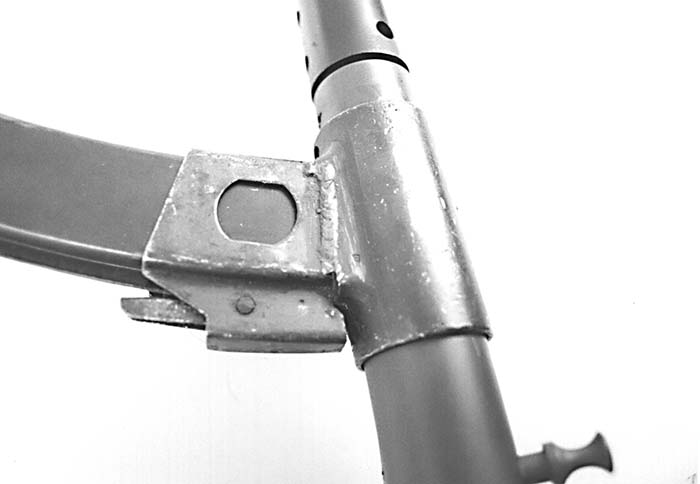
Since the Tokarev cartridge was appreciably longer than the 9mm Parabellum a different magazine was required to convert the Sten. The logical choice for a magazine was the one being used in the standard Chinese submachine gun of the time, the Type 54. The Type 54 weapon was the Chinese clone of the more commonly known Russian PPS43 submachine gun. The magazine was a reliable double-stack double-feed design that had a maximum capacity of 35 rounds. The Stens that were converted to 7.62 by Chinese arsenals also utilized the magazine housing from the Type 54. The Type 54 SMG housing was attached by being welded onto a modified original Sten housing. Since the Type 54 magazine is a double feed type, the bolt also had to be modified. A special .30 caliber barrel was produced for the conversion. It was longer than the normal Sten 9mm barrel at 10.5”, and had a chromed bore and chamber, for use with corrosive ammunition. The Sten’s original fixed sights calibrated for the 9mm remained unchanged in the 7.62 Chinese conversion. It was considered unimportant to the Chinese Army of the period, as marksmanship was not as important as massed firepower. With the Sten firing the Tokarev cartridge both the rate of fire and the muzzle report were noticeably increased.
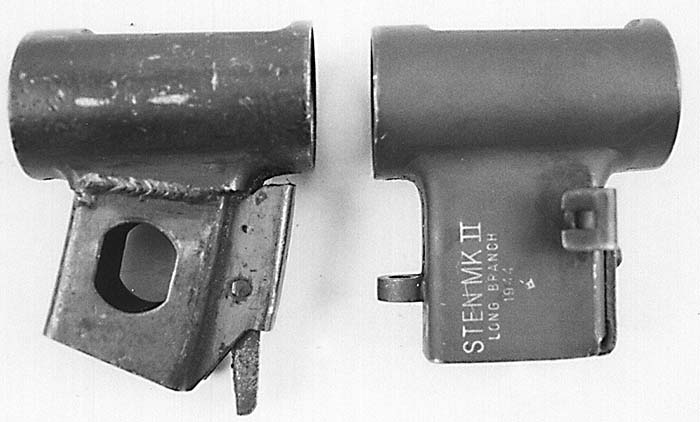
Just a few years ago, Chinese manufactured kits for converting the 9mm Sten to the 7.62x25mm Tokarev caliber were available from surplus dealers. The kits have long since sold out, but occasionally are offered for sale by individuals. The kits consisted of: a modified Sten magazine housing a Type 54 SMG magazine, a Sten bolt that was modified to feed from the double stack Type 54 magazine, a 10.5-inch 7.62x25mm barrel and a special high rate recoil spring.
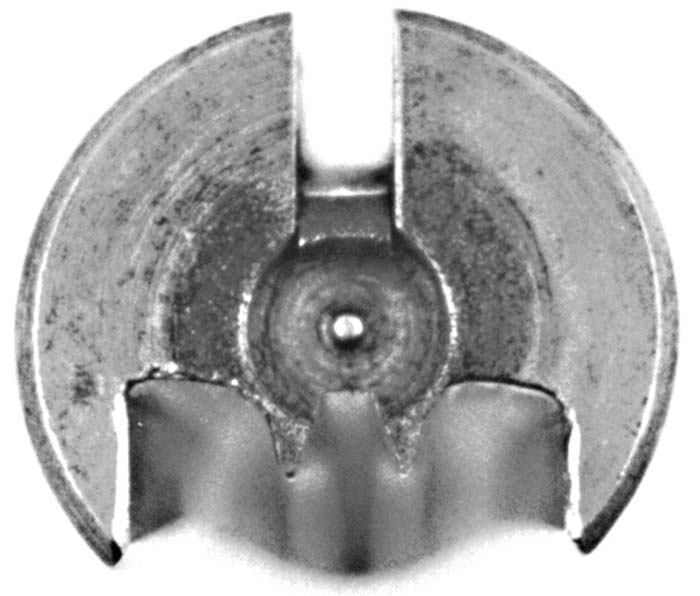
Although complete 7.62x25mm caliber conversion kits are for the most part unavailable, Chinese manufactured barrels for the Sten chambered for the 7.62x25mm round are still occasionally advertised by surplus parts dealers.
There have been a few former Chinese contract Stens documented that have the aforementioned 9mm housings with Chinese markings, but have had additional markings added that translate into: “7.62 conversion 54”. This would indicate the Chinese converted some Stens to 7.62×25 using the original Sten 9mm housing. It is believed that the Chinese were able to retain the original Sten housings by altering the Type 54 magazine, rather then the housing. The Type 54 or PPS43 magazine can be altered to fit into a standard 9mm Sten housing by cutting off a portion of the rib in the rear of the magazine. The magazine would also need to be altered to use the Sten magazine catch. The base of the 9mm and 7.62x25mm cartridge are dimensionally similar and no modification to the bolt face or extractor is usually required, but the bolt would need to be machined to feed from the double-stack magazine. Although the conversion is possible it does require substantial fabricating and machining skills.
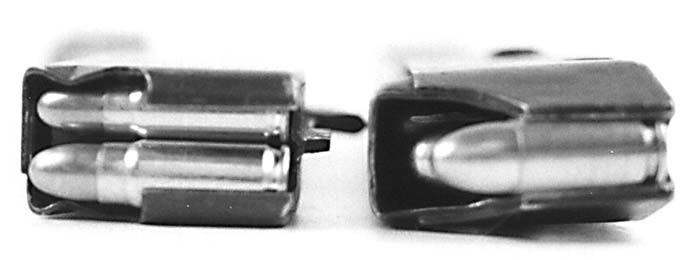
A few of the original Chinese 7.62×25 converted Sten MKII’s were imported into the United States prior to 1968. Original 7.62 Chinese Sten conversions can be easily converted back to the 9mm configuration. This re-conversion would require the replacement of the magazine housing. This would necessitate removal of the front sight. If the front sight was welded in place, you would have to cut the weld to remove it. The rest of the conversion is simply a matter of exchanging parts. The parts required would be: a 9mm magazine housing, a 9mm barrel, 9mm Sten magazines, recoil spring and a new original 9mm-bolt assembly.
The 7.26x25mm Tokarev Cartridge
The 7.62×25 Tokarev was the standard Russian pistol and submachine gun cartridge during WWII. Its popularity became more widespread after the war, when many European countries came under Communist influence, and adopted both Soviet designed weapons and ammunition. The Russians first adopted the Tokarev round in 1930 for use in their TT-30 and TT33 Tokarev semi-auto pistols. The Russian cartridge was copied directly from the 7.63 Mauser round and will generally interchange with it. The standard Soviet 7.62×25 round features an 86 grain full metal jacket projectile. The bottleneck cartridge cases on Russian and Chinese 7.62×25 ammunition are generally made of copper washed or lacquered steel. The projectile’s velocity can exceed 1600 feet per second when fired from a 10-inch submachine gun barrel, and has a very flat trajectory. The round was used in virtually all Russian submachine guns of the WWII era including the well known PPSh 41.
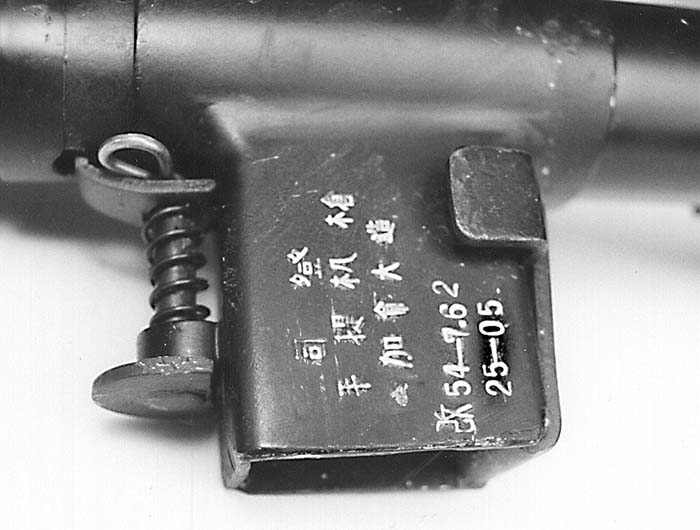
Surplus 7.62x25mm cartridges are occasionally available in the United States, but caution must be used, as much of it is corrosive. Corrosive ammunition is fine as long as you are aware of the fact and clean the weapon accordingly. Some Czechoslovakian manufactured ammunition is loaded for higher than standard velocity. This ammunition should be not be used in a converted Sten. Inexpensive non-corrosive modern Chinese 7.62×25 ammunition was once available, but is no longer importable into United States. Just recently some reloadable, very high quality commercial brass cased 7.62×25 has become available.
Jon McReynolds generously loaned the 7.62×25 conversion kit used for the photographs in this article to the author.
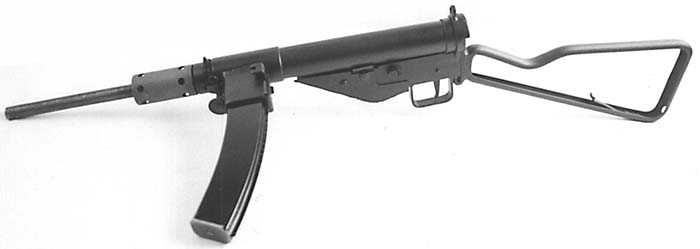
This Article was excerpted from the 2nd edition of the book; The British Sten Manual for Collectors and Shooters. The book is now available from Moose Lake Publishing LLC at 207-683-2959
| This article first appeared in Small Arms Review V5N1 (October 2001) |











